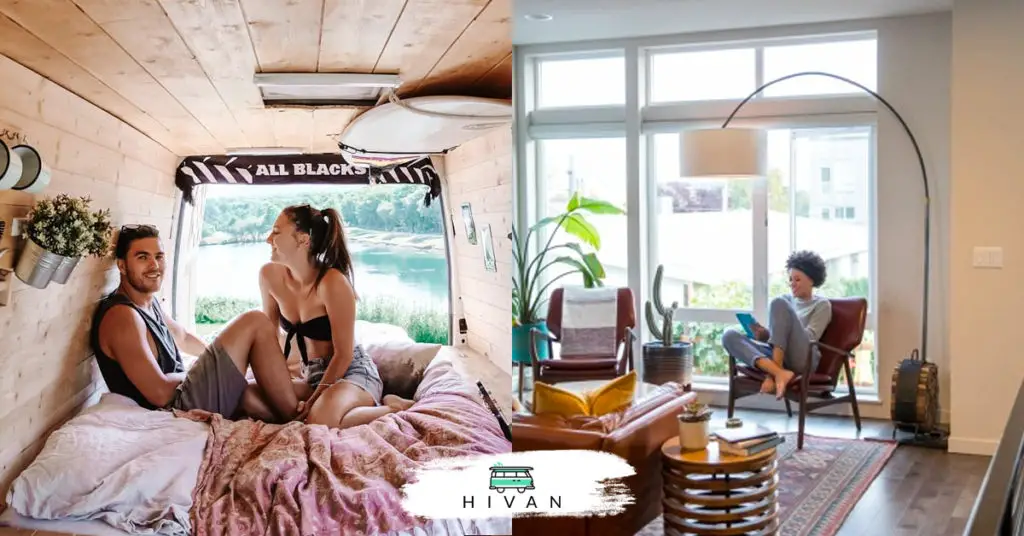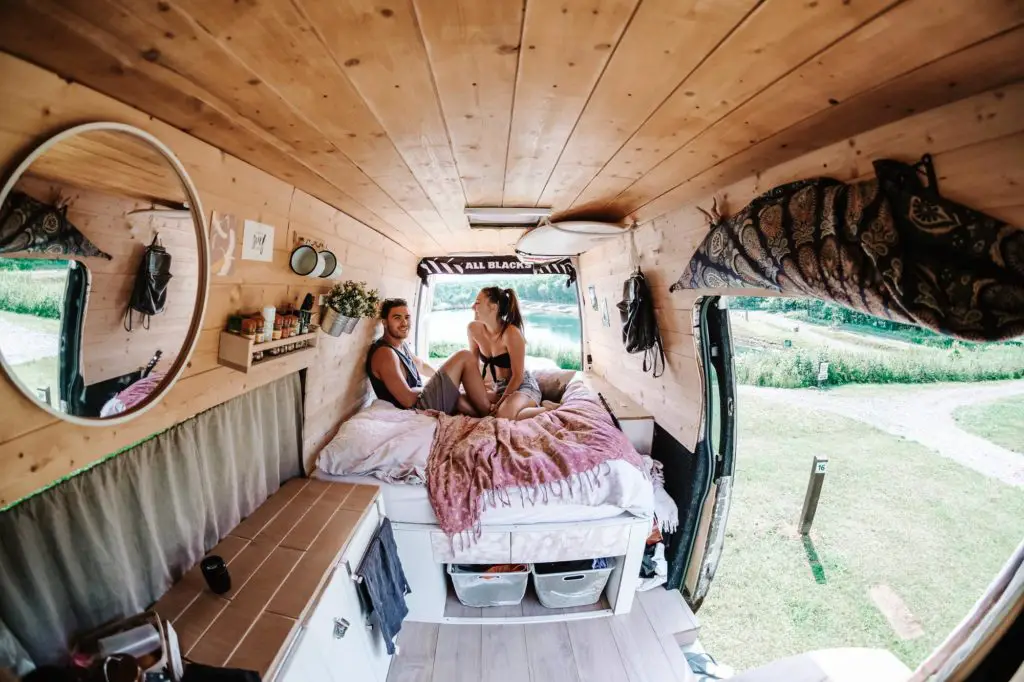Hi-van is supported by its audience. When you purchase using our links, we may earn an affiliate commission (no added cost to you). Learn more
Are you into a nomadic lifestyle, never able to stay in one place too long? Do you want to save a few bucks and gain a lot of freedom? Transforming a van into a living space is a great alternative to renting, but the question is: will it actually save you money?

Van life can be cheaper than renting if you buy a used vehicle, renovate it yourself, and furnish it with inexpensive items. Since rental rates are so high, even if you choose to purchase new, more costly products, you will likely still save some money, but not as much.
Renting and transforming a van into a home can be quite expensive; however, when customizing your van, you are in control of a lot more factors. That’s why it is possible to make your mobile home much less costly than paying a rental fee you have no control over. Keep reading to learn more about various aspects that determine the true cost of making your van into a home.
How Expensive Is Renting?

When it comes to living expenses, most people will recommend you spend no more than 30% of your income on rent. This means different things for everyone depending on your annual salary, and does not mean you have to spend that percentage on housing—you just do not want to spend more than that.
According to FRED, the average American median personal income as of 2019 is $35,977 USD. According to the 30% rule, this would be an annual allotted amount of $10,793, or just about $900 a month.
However, 2018-2019 saw renters paying a whopping median of $1,620 for unfurnished living spaces. This price clocks in at over 50% of one’s annual income. The cost of renting is much higher than what most people can afford.
Van Life – The Cost Break Down

Now that we know how much of our paycheque we can expect to dish out on rent, let’s take a look at the expenses that come with living out of a van.
Related Article: Just How Cheap Can Van Life Be? Minimum Costs Explained
Buying the Van
Buy a used van. While it might be tempting to lock down a flashy new vehicle to become your new home, the goal is to save money.
Keep your eyes peeled for deals on Craigslist, eBay, and Facebook Marketplace. If you aren’t in any rush, take your time. Exercise your patience and wait it out until you find one within your budget and in good condition. It is going to be your new home, after all.
If you get lucky, you’ll be able to find a van for as low as a few hundred dollars, but aim to keep it between $1000-$5000. Don’t forget to get a mechanic to check it out before signing the papers!
Renovation
Some work will have to go in to make your vehicle liveable. Of course, you’ll need the basics, like a bed or two, maybe some homey seating, and a kitchenette if you plan on cooking for yourself. I made a complete resource page about van build here by the way.
A great way to save some money and maximize your space is to install furniture that has multiple functions. For example, a sofa bed that can host your guests during the day and can be a great place to sleep at night.
If you’ve already got some power tools and consider yourself quite handy—or have some friends who love a good DIY project—then you can build a lot of your furniture yourself. Not only is this cheaper in most cases, but you can also customize everything to fit your space perfectly.
Check out this video to see exactly how you can build your own pull out bed at home:
According to Campervan Life, you should be able to find a sofa bed at a local reclamation yard for under $25 USD. Any other furniture you need can also be purchased at a store like this, or at thrift stores, or any second-hand platform online. However, you can purchase items at a fairly low retail price on Amazon, such as electric burners or foldable brackets, to create pullout tables.
Ultimately, the furnishings you need for your van are completely up to you, just like the furnishings in the unit you’d be renting. They can be as cheap or expensive as you’d like to make them.
Maintenance
Like all vehicles, you will need to get repairs done on your van. Depending on how often you drive it and how old the model is, you can expect to pay roughly $1,186 per year on maintenance.
If you get rid of your car when transitioning to van life, this cost will be fairly obsolete as it will just replace the maintenance fees you were already paying.
Gas
Again, the amount you pay for gas depends heavily on how frequently you drive your van. If it’s regularly parked in various spots, you’ll need refuels far less than if you’re constantly traveling around the country.
That being said, as previously mentioned, if road trips are normal events for you anyways, you’ll already be spending this amount of money on gas. If anything, you’ll be saving the cost of accommodations by staying in your mobile home.
Parking
After you’ve turned your van into a home, one of the biggest concerns is where to park it. If you’re planning on staying dormant on a budget, hotels, 24-hour stores, and Walmart parking lots are a great option as they allow you to camp in them for free.
Another great option in the city is simply parking on the street overnight in residential areas. Just be sure to double-check the signs to ensure you’re parked safely and legally. Getting a ticket won’t help you save on cash!
If living remotely is more your style, there are countless campgrounds available wherever you may be. Depending on the park and time of year, some might even be accessible without a fee. Plus, public bathrooms and showers are always important when leading the van life.
Insurance
At AAA, the average annual cost of insurance is $1,023. Your rate will be determined by a number of factors, including but not limited to your driving record, age, and location. If you’re looking for interesting deals and insurance companies, I recommend Wordnomads. They’re perfect if you’re living on the road.
If you opted to buy an older van, you’re in luck. Insurance rates are often higher for newer cars.
When compared with renter’s insurance, you’ll be spending quite a bit more on coverage for your van. As a tenant, most people pay less than $15 a month, or $180 annually.
Related Article: The Ultimate Guide to Van Life Health Insurance How Much Does Insurance Cost for a Van Conversion?
Utilities
While some buildings include utilities in the rent, you’re on your own when living from your van. Laundromats, internet, and water are all amenities to consider when transitioning to a mobile home.
If you don’t need stable wifi throughout your van, take a look at the data coverage included in your phone plan. You may already be paying for the internet connection you need.
Lots of people who live out of their vans rely on public washrooms and showers since reliable water supply can be hard to come by remotely—and a bathroom takes up a lot of valuable space. If you’re okay with this, invest in a membership to a 24-hour gym like Anytime Fitness for an average fee of $36.50 per month.
Final Thoughts
With average rental costs eating up such a high percentage of your annual income, more people are looking into cheaper alternatives. Turning your van into a home can be a great option to save money—if it’s done right. Choosing to purchase your vehicle and furnishings second-hand while accessing free parking will cut down your costs.
Other fees associated with your new home are expenses you already pay if you have a car, such as insurance, maintenance, and gas. While van life comes with some potential sacrifices like space and running water, if you are happy to live nomadically and shower at the gym, you can save some serious coin.
Find this content useful 🙂 ?
Subscribe to our Newsletter and get a free Solar Electric Diagram + shopping list.

